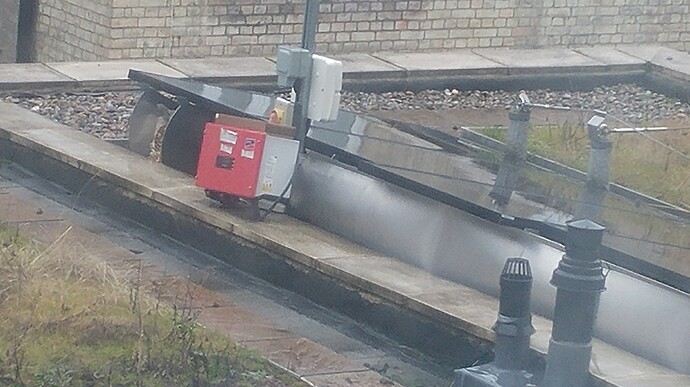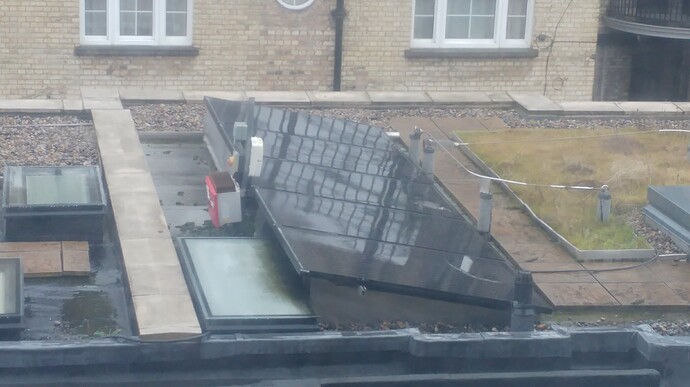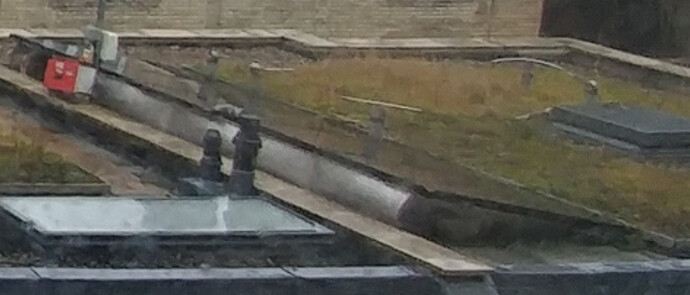I have been recently in London and saw this solar panel arrangement on a roof. Can anyone explain what is that box with a huge heat sink on top?
That looks like a SMA sunny boy inverter, I’ve never seen one mounted on a roof before.
The disipator on the top is possibly for g83 compliance where the grid isn’t guaranteed to able to consume the output of the array, so the inverter needs to be able to dump up to 100% of production.
E.g.
https://www.renugen.co.uk/sma-sunny-boy-1300tl-10-inverter-g83-2/
Thanks, and what about the white and gray boxes on the mast?
The white had a green led at the front side.
I think they are too generic looking to be sure, but there seems to be a lever-looking bit on the LHS of the smaller grey box, that could be an isolator? As for the white box it’s anyone’s guess, but if it was a generation meter (perhaps even in a windowed waterproof box) you would have an entire grid tied PV setup for UK FiT ( feed-in tarriff) installed entirely on the roof, almost a “plug in PV farm in a box” possibly the cheapest ever install method.
[edit - maybe an early rent’a’roof install?]
Paul,
If I understand the physics correctly, can’t the inverter simply stop converting? At infinite load (i.e. current draw zero) the panel V becomes Voc and the power captured is Voc * 0 = 0. I guess this implies the panel gets hotter due to absorbing by say 15% more of the solar gain, but for a rare and probably short event, does this matter?
I’m not in a position to answer these questions definitively. But I recognized the inverter casing and labels, but my own inverter of that type did not have the heatsink, my own is not G83 and having some mild exposure to G83 installs via one of my clients (I do thier monitoring installs) I put 2 and 2 together to take a stab at why that might have a heatsink. A small amount of searching supported my suspisions by the fact G83 seemed to appear in the model description for those with heatsink but not those without, but my search wasn’t extensive.
As for this possibly being a “rare and probably short event,” I think not. The grid connection is monitored and then the Inverters are throttled when the export exceeds what is deemed safe by the DNO, I think the limit can be either static or DNO controlled remotely.
One example I can think of is a school that has 3 huge solar roof installs, these provide ample electricity for most of the quite large school most of the year, in winter months during peak demand they still import a significant amount, but come summer there is surplus more often than not during a normal school day, but during the long evenings when the school is using no energy but the sun is high, the inverters have to dump most if not all the energy for hours and all day at the weekends. In the 6weeks summer holidays that is 7 days a week, I’ve been there during the summer hols to do additional work and you could literally fire bricks in the plant rooms.
Added two more photo on the first page.
Other thing i’m curious is why the arrays have a side wall under them made of what looks like aluminium sheet.
Looking at the install on the far right of the 3rd pic, it looks like that thin sheet is supporting the array and not doing a very good job of it going by the bulging!
Both the inverters look like they are hanging off in that pic too, I’m more drawn to the idea these are probably old rent’a’roof type installs.
Looking at it again, it looks like that is the only array that has a side, possibly because the array overhangs the skylight so the rear support couldn’t run the full width and needed the addition of the end panel.
I thought it would be some kind of factory made (heat ?) preservation shield, but the bulging as you said seems to be due to supporting the weight.
Something like that would be counter-productive as the hotter a PV module gets, the less
energy it produces. You’d normally want air circulation under a module to prevent heat build-up.
It almost looks like what we’d (in the US) call flashing. A thin sheet used to help keep out rain.
But that is strictly a WAG.
Same here - usually zinc or lead, but can be roofing felt.
Yep. Galvanized Steel sheet metal.
We used to use Lead, but it was outlwed for that purpose many moons ago.



